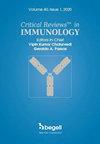基于网络药理学和实验验证的异佛司可林抗哮喘机制探索
IF 0.9
4区 医学
Q4 IMMUNOLOGY
引用次数: 0
摘要
研究目的本研究采用网络药理学结合生物学实验验证的方法筛选异佛司可林(ISOF)的靶点,并探讨ISOF作用于哮喘的潜在内在机制:方法:从Genecards和DisGeNET数据库中筛选哮喘相关靶点。方法:从Genecards和DisGeNET数据库中筛选哮喘相关靶标,并利用SEA和Super-PRED数据库获得ISOF的靶标。通过基因本体(GO)和京都基因组百科全书(KEGG)分析,确定了ISOF作用于哮喘的关键靶点和富集调控通路。然后,通过STRING数据库构建了蛋白-蛋白相互作用(PPI)网络,并利用分子对接技术进一步筛选了ISOF对哮喘的枢纽基因。最后,通过CCK-8、qPCR和Western blotting等方法评估了ISOF治疗哮喘的靶点:结果:从相关数据库中共筛选出96个药物相关疾病靶点。KEGG通路富集分析预测这些靶基因可能参与了PI3K-Akt通路。通过PPI网络和分子对接,确定了ISOF治疗哮喘的核心靶点,包括MAPK1、mTOR和NFKB1。体外实验一致表明,ISOF通过降低MAPK1、mTOR和NFKB1的表达参与了炎症反应:本研究表明,MAPK1、mTOR 和 NFKB1 可能是异佛司可林治疗哮喘的关键靶点,其抗哮喘作用可能与 PI3K-AKT 信号通路有关。本文章由计算机程序翻译,如有差异,请以英文原文为准。
Exploring the mechanism of Isoforskolin against asthma based on network pharmacology and experimental verification
Objective: In this study, network pharmacology combined with biological experimental verification was utilized to screen the targets of Isoforskolin (ISOF) and investigate the potential underlying mechanism of ISOF acting on asthma.
Methods: Asthma-related targets were screened from the Genecards and DisGeNET databases. SEA and Super-PRED databases were used to obtain the targets of ISOF. Gene Ontology (GO) and Kyoto Encyclopedia of Genes and Genomes (KEGG) analysis were employed to identify key targets and enriched regulatory pathways of ISOF acting on asthma. Then, a protein-protein interaction (PPI) network was constructed via STRING database and hub genes of ISOF against asthma were further screened using molecular docking. Finally, CCK-8, qPCR, and western blotting were performed to assess the targets of ISOF in treating asthma.
Results: A total of 96 drug-related-disease targets from the relevant databases were screened out. KEGG pathway enrichment analysis predicted that the target genes might be involved in the PI3K-Akt pathway. The core targets of ISOF in treating asthma were identified by the PPI network and molecular docking, including MAPK1, mTOR, and NFKB1. Consistently, in vitro experiments showed that ISOF acting on asthma was involved in inflammatory response by reducing the expression of MAPK1, mTOR, and NFKB1.
Conclusions: The present study reveals that MAPK1, mTOR, and NFKB1 might be key targets of Isoforskolin in asthma treatment and the anti-asthma effect might be related to the PI3K-AKT signaling pathway.
求助全文
通过发布文献求助,成功后即可免费获取论文全文。
去求助
来源期刊
CiteScore
2.60
自引率
0.00%
发文量
14
审稿时长
>12 weeks
期刊介绍:
Immunology covers a broad spectrum of investigations at the genes, molecular, cellular, organ and system levels to reveal defense mechanisms against pathogens as well as protection against tumors and autoimmune diseases. The great advances in immunology in recent years make this field one of the most dynamic and rapidly growing in medical sciences. Critical ReviewsTM in Immunology (CRI) seeks to present a balanced overview of contemporary adaptive and innate immune responses related to autoimmunity, tumor, microbe, transplantation, neuroimmunology, immune regulation and immunotherapy from basic to translational aspects in health and disease. The articles that appear in CRI are mostly obtained by invitations to active investigators. But the journal will also consider proposals from the scientific community. Interested investigators should send their inquiries to the editor before submitting a manuscript.

 求助内容:
求助内容: 应助结果提醒方式:
应助结果提醒方式:


